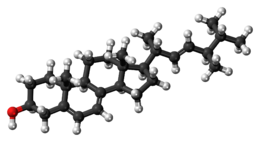Ergosterol/ja: Difference between revisions
Created page with "{{Vitamins/ja}} {{Cholesterol and steroid intermediates/ja}} {{Phytosterols/ja}}" |
Created page with "プレビタミンとビタミンD<sub>2</sub>の混合物を含む照射エルゴステロールの製剤は、1930年代には''ビオステロール''と呼ばれていた。" |
||
| Line 83: | Line 83: | ||
</div> | </div> | ||
プレビタミンとビタミンD<sub>2</sub>の混合物を含む照射エルゴステロールの製剤は、1930年代には''ビオステロール''と呼ばれていた。 | |||
==毒性{{Anchor|Toxicity}}== | ==毒性{{Anchor|Toxicity}}== | ||
Revision as of 10:40, 11 April 2024

| |

| |
| Names | |
|---|---|
| IUPAC name
(22E)-Ergosta-5,7,22-trien-3β-ol
| |
| Systematic IUPAC name
(1R,3aR,7S,9aR,9bS,11aR)-1-[(2R,3E,5R)-5,6-Dimethylhept-3-en-2-yl]-7-hydroxy-9a,11a-dimethyl-2,3,3a,6,7,8,9,9a,9b,10,11,11a-dodecahydro-1H-cyclopenta[a]phenanthren-7-ol | |
| Identifiers | |
3D model (JSmol)
|
|
| ChEBI | |
| ChEMBL | |
| ChemSpider | |
| EC Number |
|
| MeSH | Ergosterol |
PubChem CID
|
|
| UNII | |
| |
| |
| Properties | |
| C28H44O | |
| Molar mass | 396.65 g/mol |
| Melting point | 160 °C (320 °F; 433 K) |
| Boiling point | 250 °C (482 °F; 523 K) |
| -279.6·10−6 cm3/mol | |
エルゴステロール(ergosta-5,7,22-trien-3β-ol)は、菌類や原生動物の細胞膜に存在するマイコステロールの一種で、コレステロールが動物細胞で果たすのと同じ機能の多くを果たす。多くの菌類や原生動物はエルゴステロールなしでは生存できないため、エルゴステロールを合成する酵素は創薬の重要な標的となっている。ヒトの栄養学において、エルゴステロールはビタミンD2のプロビタミン形態であり、紫外線(UV)にさらされると化学反応を起こしてビタミンD2を生成する。
Role in fungi
Ergosterol (ergosta-5,7,22-trien-3β-ol) is a sterol found in fungi, and named after ergot, the common name of members of the fungal genus Claviceps from which ergosterol was first isolated. Ergosterol is a component of yeast and other fungal cell membranes, serving many of the same functions that cholesterol serves in animal cells. Its specificity in higher fungi is thought to be related to the climatic instabilities (highly varying humidity and moisture conditions) encountered by these organisms in their typical ecological niches (plant and animal surfaces, soil). Thus, despite the added energy requirements of ergosterol synthesis (if compared to cholesterol), ergosterol is thought to have evolved as a nearly ubiquitous, evolutionarily advantageous fungal alternative to cholesterol. This advantage could be linked to the presence of two conjugated double bonds in the structure (B-ring) of ergosterol giving it antioxidant properties.
Target for antifungal drugs
Because ergosterol is present in cell membranes of fungi, yet absent in those of animals, it is a useful target for antifungal drugs. Ergosterol is also present in the cell membranes of some protists, such as trypanosomes. This is the basis for the use of some antifungals against West African sleeping sickness.
Amphotericin B, an antifungal drug, targets ergosterol. It binds physically to ergosterol within the membrane, thus creating a polar pore in fungal membranes. This causes ions (predominantly potassium and hydrons) and other molecules to leak out, which will kill the cell. Amphotericin B has been replaced by safer agents in most circumstances, but is still used, despite its side effects, for life-threatening fungal or protozoan infections.
Fluconazole, miconazole, itraconazole, clotrimazole, and myclobutanil work in a different way, inhibiting synthesis of ergosterol from lanosterol by interfering with 14α-demethylase. Ergosterol is a smaller molecule than lanosterol; it is synthesized by combining two molecules of farnesyl pyrophosphate, a 15-carbon-long terpenoid, into lanosterol, which has 30 carbons. Then, two methyl groups are removed, making ergosterol. The "azole" class of antifungal agents inhibit the enzyme that performs these demethylation steps in the biosynthetic pathway between lanosterol and ergosterol.
Target for antiprotozoal drugs
Some protozoa, including Trichomonas and Leishmania are inhibited by drugs that target ergosterol synthesis and function
As a vitamin D2 precursor
Ergosterol is a biological precursor of vitamin D2, the chemical name of which is ergocalciferol. Exposure of white button mushrooms to UV-C irradiation at 0.403 mW per cm2 intensity from 30 cm distance produced time-dependent increases in vitamin D2 concentrations.
This happens naturally to a certain extent, and many mushrooms are irradiated after harvest to increase their vitamin D content. Fungi are also grown industrially so that ergosterol can be extracted and converted to Vitamin D for sale as a dietary supplement and food additive.
プレビタミンとビタミンD2の混合物を含む照射エルゴステロールの製剤は、1930年代にはビオステロールと呼ばれていた。
毒性
エルゴステロール粉末は、皮膚、目、呼吸器官を刺激する。多量の摂取は高カルシウム血症を引き起こす可能性があり、(長引くと)軟部組織および腎臓にカルシウム塩が沈着する。
こちらも参照